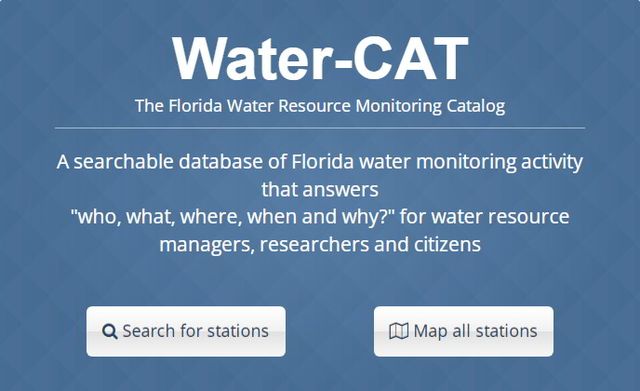Link:Florida Water Resource Monitoring Catalog: Difference between revisions
No edit summary |
No edit summary |
||
| Line 2: | Line 2: | ||
|Name=Florida Water Resource Monitoring Catalog | |Name=Florida Water Resource Monitoring Catalog | ||
|Link Url=https://water-cat.usf.edu/ | |Link Url=https://water-cat.usf.edu/ | ||
|Description=The | |Description=The Florida WaterResource Monitoring Catalog is a searchable database of metadata, that allows anyone to find information about water resource monitoring activities in Florida. | ||
|Text_Body=The Florida Water Resource Monitoring Catalog is a searchable database of [https://www.fgdc.gov/metadata metadata]—"data about data"—that allows anyone with access to the internet to find information about [https://floridadep.gov/dear/watershed-monitoring-section water resource monitoring] activities in Florida. Each metadata element describes a sample site where information of some sort (chemical, physical, biological) is being collected about an individual water resource (lake, stream, estuary, ocean, watershed, aquifer, etc.). Metadata are contributed by individual organizations (local, state and federal environmental agencies, educational and research institutions, environmental consultants, testing laboratories, volunteer monitoring groups) that are performing the monitoring. Metadata are acquired directly from the organization performing the monitoring, or indirectly via regulatory agencies that receive routine submissions of water resource data. | |Text_Body=The [https://water-cat.usf.edu/ Florida Water Resource Monitoring Catalog] is a searchable database of [https://www.fgdc.gov/metadata metadata]—"data about data"—that allows anyone with access to the internet to find information about [https://floridadep.gov/dear/watershed-monitoring-section water resource monitoring] activities in Florida. Each metadata element describes a sample site where information of some sort (chemical, physical, biological) is being collected about an individual water resource (lake, stream, estuary, ocean, watershed, aquifer, etc.). Metadata are contributed by individual organizations (local, state and federal environmental agencies, educational and research institutions, environmental consultants, testing laboratories, volunteer monitoring groups) that are performing the monitoring. Metadata are acquired directly from the organization performing the monitoring, or indirectly via regulatory agencies that receive routine submissions of water resource data. | ||
The goal of the Catalog is to help water resource managers better protect, preserve, manage and restore water resources in the state of Florida, by making it easier for them to coordinate water resource monitoring efforts and share information. The Catalog can also help researchers by letting them know what data have been collected, where they were collected, and how to acquire the data for their own analysis. Members of the public can use the Catalog to find out about monitoring activities being performed in their communities. | The goal of the Catalog is to help water resource managers better protect, preserve, manage and restore water resources in the state of Florida, by making it easier for them to coordinate water resource monitoring efforts and share information. The Catalog can also help researchers by letting them know what data have been collected, where they were collected, and how to acquire the data for their own analysis. Members of the public can use the Catalog to find out about monitoring activities being performed in their communities. | ||
Revision as of 18:09, March 24, 2023
The goal of the Catalog is to help water resource managers better protect, preserve, manage and restore water resources in the state of Florida, by making it easier for them to coordinate water resource monitoring efforts and share information. The Catalog can also help researchers by letting them know what data have been collected, where they were collected, and how to acquire the data for their own analysis. Members of the public can use the Catalog to find out about monitoring activities being performed in their communities.
The Catalog project is sponsored by the Florida Department of Environmental Protection (DEP), with funding from the U.S. Environmental Protection Agency . The Florida Water Resource Monitoring Council, created and coordinated by the DEP, is composed of stakeholders from many organizations and disciplines that participate in water resource monitoring and management statewide. Members of the Council provided guidance during the design and development of the Catalog. Design and implementation of the database and online tools to access it are being performed by the USF Water Institute at the University of South Florida in Tampa.
The Catalog project was initially proposed in 2008 as part of the Council's Monitoring-Coordination Action Plan. Development was initiated in May 2013 and is substantially complete. It is anticipated that the Catalog will be retained indefinitely, with ongoing support for new metadata submissions, routine maintenance and scheduled updates.
Sample sites represented in the catalog are located throughout the state of Florida. They monitor inland and coastal resources, water bodies (lakes, streams, bays, estuaries, oceans) and groundwater resources. Geographic Information Systems (GIS) technology is used by the Catalog to map sample sites to specific locations and to allow spatial searches.

